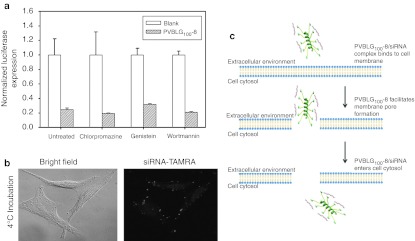Figure 8.
Modes of PVBLG100-8:siRNA complex uptake. (a) In vitro transfection of HeLa-Luc cells with luciferase siGL3 using helical PVBLG100-8 in the presence or absence of endocytic inhibitor drugs. PVBLG100-8:siRNA complexes were formed at a 10:1 PVBLG100-8:siRNA weight ratio. Complexes between lipofetamine 2000 (LFA) and siRNA were formed at a 5:1 LFA:siRNA weight ratio. The final short interfering RNA (siRNA) concentration was 100 nmol/l in all cases. Combined the data indicates that PVBLG100-8:siRNA complexes do not use any of the traditional forms of cell uptake. (b) Fluorescence microscopy of HeLa-Luc cells transfected at 4 °C with complexes formed with TAMRA-labeled siRNA and helical PVBLG100-8 to demonstrate uptake even in the absence of active endocytosis. (c) In a proposed model for PVBLG100-8:siRNA complex entry into cells, small siRNA molecules are first weakly bound to the larger and cationic PVBLG100-8 which in turn is electrostatically attracted to anionic cell membranes. PVBLG100-8 then facilitates cell membrane disruption, allowing PVBLG100-8:siRNA complexes to diffuse into the cell cytosol.

